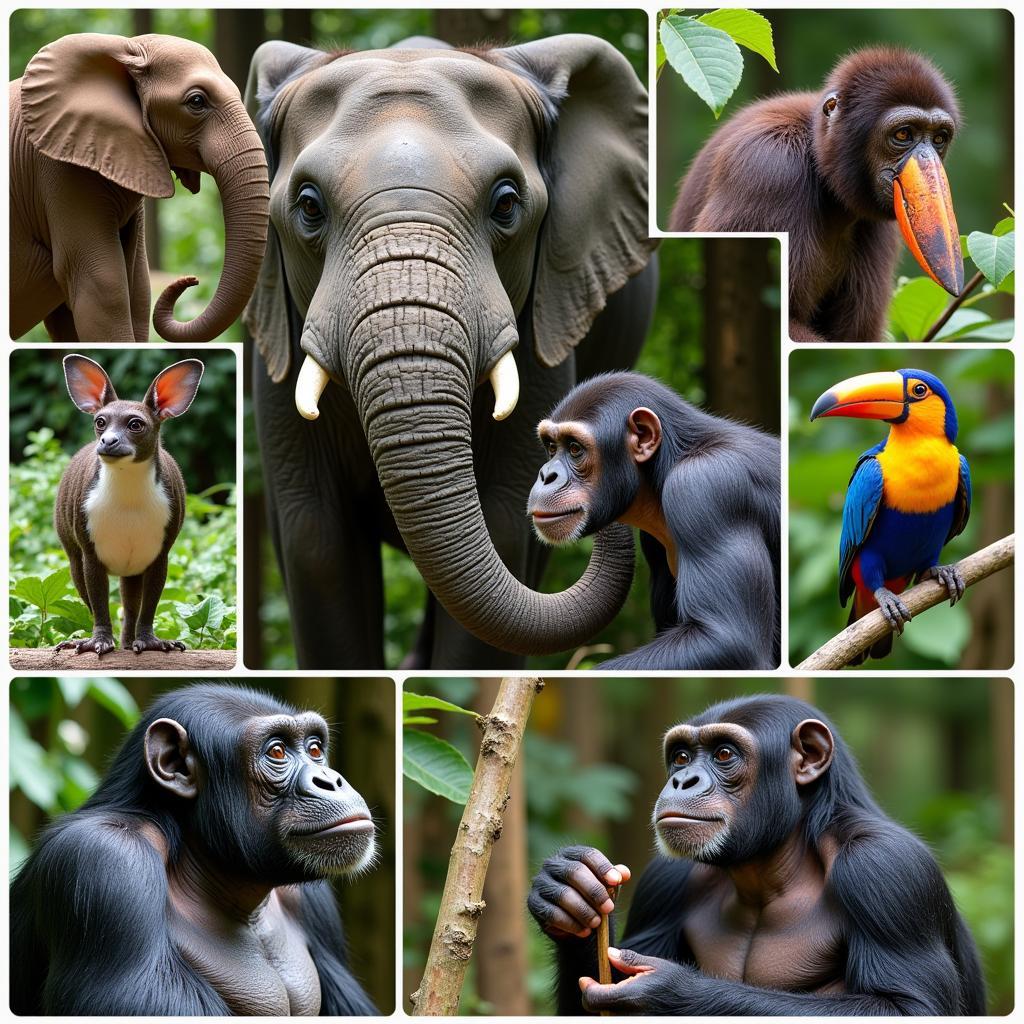The Difference Between African and Asian Elephants
From their majestic size to their complex social structures, elephants are truly remarkable creatures. But did you know that there isn’t just one kind of elephant? In fact, there are key differences between African and Asian elephants that distinguish these two iconic animals. This article will delve into the fascinating distinctions between these giants, exploring their physical characteristics, habitats, behaviors, and conservation challenges.
Unraveling the Differences: A Tale of Two Continents
While both African and Asian elephants share the title of largest land mammals on their respective continents, they possess unique features that set them apart.
Size and Stature: A Matter of Proportions
One of the most obvious differences lies in their size. African elephants are significantly larger than their Asian counterparts. The African forest elephant weight can reach up to several tons. Males can grow up to 13 feet tall at the shoulder and weigh up to 6 tons, while females are slightly smaller. In contrast, Asian elephants are generally shorter, with males reaching about 9-10 feet tall and weighing up to 5.5 tons.
Ears That Tell a Tale: Spotting the Difference from Afar
The shape of their ears offers another quick way to differentiate between the two. African elephants possess large, fan-shaped ears that resemble the African continent itself. These impressive ears help regulate their body temperature by dissipating heat. On the other hand, Asian elephants have smaller, more rounded ears that are less prominent in relation to their body size.
Tusks of Ivory: Not All Elephants Are Created Equal
Another distinguishing feature lies in their tusks. Both male and female African elephants typically have tusks, while only some male Asian elephants have them. Tusks are elongated incisor teeth made of ivory, and they play a vital role in foraging, digging, and defense. Unfortunately, the illegal ivory trade has had a devastating impact on elephant populations worldwide, particularly targeting those with large tusks.
Skin Deep: Variations in Texture and Color
While both species have thick, gray skin, there are subtle differences in texture and color. African elephants tend to have rougher, more wrinkled skin, while Asian elephants have smoother skin with patches of depigmentation, particularly on their forehead and trunk.
Beyond Appearance: Exploring Behavioral and Ecological Differences
The distinctions between African and Asian elephants extend far beyond their physical characteristics, encompassing their behaviors, social structures, and ecological roles.
Social Butterflies vs. Matriarchal Herds: A Glimpse into Elephant Societies
African elephants are known for their large, complex herds that can consist of dozens of individuals, often led by a matriarch—the oldest and most experienced female. These herds are highly social, with strong bonds between members. Asian elephants, on the other hand, tend to live in smaller family groups, usually led by a matriarch and her female offspring.
Browsers vs. Grazers: Dietary Preferences and Adaptations
Their diets also differ, reflecting their respective habitats. African elephants are primarily browsers, meaning they feed on leaves, branches, and fruits from trees and shrubs. Their long trunks and powerful tusks are well-suited for reaching high branches and stripping bark. Asian elephants, on the other hand, are mainly grazers, feeding on grasses, bamboo, and other vegetation found closer to the ground. Their trunks are more dexterous and allow them to grasp and manipulate smaller food items.
Conservation Challenges: Protecting Giants Under Threat
Sadly, both African and Asian elephants face numerous threats, primarily due to human activities. Habitat loss, driven by deforestation and land conversion for agriculture, is a major concern for both species. The illegal wildlife trade, particularly for ivory, continues to threaten elephant populations, despite international efforts to combat poaching. Human-elephant conflict, arising from competition for resources and space, also poses a significant challenge.
Did you know?
- African elephants can communicate over long distances using infrasound—sounds that are too low for humans to hear.
- An elephant’s trunk is a remarkable organ with over 40,000 muscles, allowing for incredible dexterity and strength.
- Asian elephants have been domesticated for centuries and are used in logging and religious ceremonies in some parts of Asia.
Frequently Asked Questions
Are African and Asian elephants able to interbreed?
While they share a common ancestor, African and Asian elephants are genetically distinct and cannot interbreed. The African and Asian elephant mixed is a myth.
What is the biggest threat to elephants today?
The biggest threat to both African and Asian elephants is habitat loss and fragmentation due to human activities, followed closely by poaching for ivory and the illegal wildlife trade.
How long do elephants live?
Elephants have a similar lifespan to humans, with both African and Asian elephants living an average of 60-70 years in the wild.
What is being done to protect elephants?
Conservation efforts include establishing protected areas, anti-poaching patrols, community-based conservation programs, and raising awareness about the plight of elephants.
How can I help elephant conservation?
You can support elephant conservation by supporting reputable organizations, spreading awareness, reducing your ecological footprint, and advocating for responsible tourism practices.
Exploring Further: Delving Deeper into the World of Elephants
To learn more about these magnificent creatures, be sure to explore our other articles on African elephants:
- Discover fascinating African elephant fun facts
- Understand the African forest elephant classification
- Find out more about the African elephant diet in the wild
Understanding the Difference Between African And Asian Elephants is crucial for appreciating the diversity of the natural world and for supporting effective conservation efforts to protect these iconic species for generations to come.
For further assistance, feel free to contact us at:
Phone Number: +255768904061
Email: kaka.mag@gmail.com
Address: Mbarali DC Mawindi, Kangaga, Tanzania
Our dedicated customer support team is available 24/7 to address your queries.



